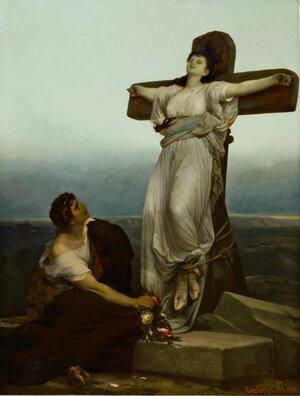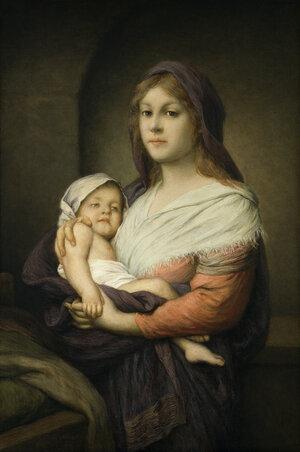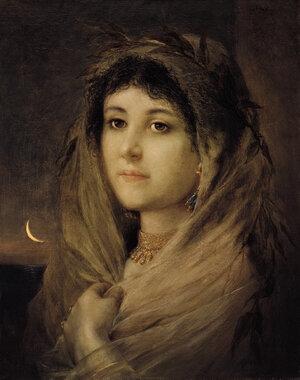This would normally be the season for the Frye’s annual Halloween Tour but since it’s currently not prudent to gather in groups, I humbly present a small digital version of that popular event, focusing on one of my favorite spooky artists of the Frye’s permanent collection: Gabriel von Max (German, born Bohemia, 1840–1915).

Oil on paper mounted on canvas. 48 x 36 3/4
in. Frye Art Museum, Founding Collection,
Gift of Charles and Emma Frye, 1952.116.
Photo: Spike Mafford.
So what makes him a little bit of an early Goth, in my mind? Well, he was not only a fine painter and natural history enthusiast, but he was also kind of a “ghostbuster” of sorts as one of the founding members of the Munich Parapsychological Society. Max was extremely interested in the nature of the soul and was particularly keen on using scientific methods to study phenomena like out-of-body experiences, astral projection, and life after death. His fascination with liminal states of being can be seen quite clearly in a number of his paintings, including The Christian Martyr in the Founding Collection at the Frye. This painting was the one that really launched Max’s career and you can probably see why it was so stunning and controversial to audiences of the time as the figure on the cross is a woman. Not only is the gender switch of the crucifixion scene unusual, but the body language and facial expression of the beautiful young martyress is also not one of agony as one might expect to see from a body in such a position of torture. She looks pale, but does not quite have the waxen complexion of a corpse yet nor has her body slumped lifelessly. She appears to be in that moment of passing from this world into the next, with a serene countenance that indicates that her soul is ascending to her heavenly reward for her sacrifice.

Child), ca. 1909. Oil on canvas. 39 1/2 x
26 1/2 in. Founding Collection, Gift of Charles
and Emma Frye, 1952.120. Photo Credit:
Eduardo Calderón.
Another Max painting that I find fascinating and that I think speaks to his interest in how death intersects with life in unexpected ways is Mother and Child. At first glance, this is a fairly common subject that painters have been portraying for centuries, often in a religious context with the figures standing in for the Virgin Mary cradling the infant Jesus. But look a little closer at the child and then at the expression on the mother’s face. The baby’s expression is slack, the eyes half-lidded and the limbs heavy and limp. The mother’s lips are tight and she’s looking away from the child, not quite at the viewer. Though we have no way to know for certain, the painting makes me wonder if its inspiration was taken from postmortem photography. This was a popular practice during Max’s time for preserving images of loved ones who had untimely passed, particularly infants or young children, of whom this might be the sole image a family had to remember them by. Postmortem photography was so widespread during the latter half of the 19th century that some photographers specialized in these types of portraits. Early photographic technology required that the sitter stay extremely still for a fairly long period of time to expose the plates inside the camera, and thus special concealed braces and stands were part of the photographer’s arsenal of equipment. These could easily be retrofitted to assist in posing the dead to look relatively life-like. Often, bereaved parents, mothers in particular, were posed holding their lost child or baby as though they were still living. If you are interested in learning more about this tradition, the Thanatos Archive is an online resource for preserving postmortem and mourning photography. Even today, parents of children who pass at birth or shortly thereafter are often offered the services of volunteer photographers who visit hospitals to help them to document their children with love and dignity, as I feel Max may have done here in this painting made over a century ago.
Finally, a poetic tidbit for you for reading this far. Gabriel von Max’s Bride of Corinth is a reference to a popular poem of the same name by the German lion of letters, Johann Wolfgang von Goethe. It’s thought to be one of the earliest examples of vampire fiction in literature.
The Bride of Corinth [From my grave to wander]
Johann Wolfgang von Goethe - 1749-1832
"From my grave to wander I am forc'd
Still to seek The God's long-sever'd link,
Still to love the bridegroom I have lost,
And the life-blood of his heart to drink;
When his race is run,
I must hasten on,
And the young must 'neath my vengeance sink.
"Beauteous youth! no longer mayst thou live;
Here must shrivel up thy form so fair;
Did not I to thee a token give.
Taking in return this lock of hair?
View it to thy sorrow!
Grey thou'lt be to-morrow,
Only to grow brown again when there."
"Mother, to this final prayer give ear!
Let a funeral pile be straightway dress'd;
Open then my cell so sad and drear,
That the flames may give the lovers rest!
When ascends the fire
From the glowing pyre,
To the gods of old we'll hasten, blest."

Happy Halloween!
Lynn Rosskamp
Gallery Guide, Halloween Tour Guide